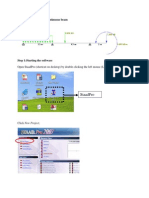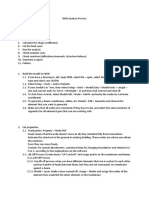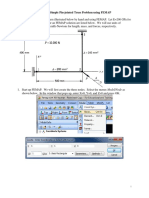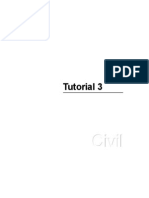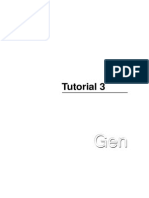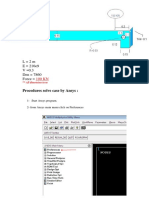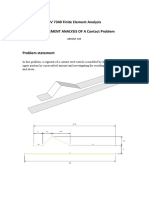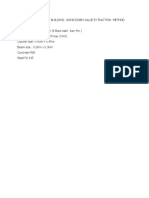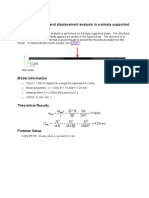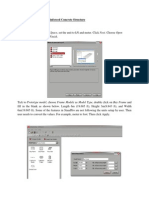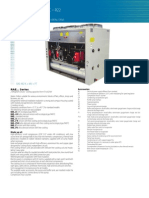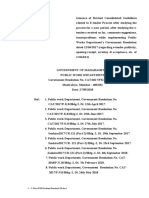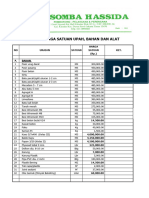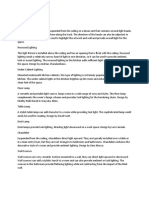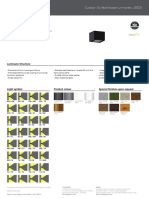OASYS SOFTWARE LAB 28TH OCTOBER, 2009
STEP 1
Change the structure type to PLANE, change units from N to KN and
Kg to t.
STEP 2
Need to define Nodes
Select Nodes from the bottom of the screen and enter coordinates.
Node X coordinate Y coordinate
1 0 0
2 4 0
3 8 0
4 12 0
5 16 0
6 0 3
7 4 3
8 8 3
9 12 3
10 16 3
pin 4x4=16m roller
1
�STEP 3
Click on the label icon at the right hand corner of the screen.
When window pops up choose from Nodes - dots and nodes & node
preferences and from Elements - element reference and property
reference.
(The Nodes will then be numbered.)
STEP 4
Click on the add elements sculpt tools on the left hand corner of the
page and join the nodes together.
1–2
2-3
3-4
4-5
6-7
7-8
8-9
9-10
1-6
2-7
3-8
4-9
5-10
1-7
2-8
3-9
2
� 4-10
Step 5- Need to add Section properties
Click on the sections tab at the bottom of the screen.
Under Name type RHS in row 1
Use tab to get steel in the material’s column.
Under the Description column choose the wizard icon on the toolbar.
(N.B. You can use wizard to choose from catalogue or decide on your
own.)
Choose from catalogue
Change type to Rectangular Hollow Section( RHS 80x40x8)
Use a circular shape w/ 20mm diameter (in row 2)-> 20mm Bar in
Name column
STEP 6
Click on the elements tab at the bottom of the screen.
Change Type from Beam to Bar.
From element 14 to 21, Change 1 to 2
Element Type Property Group
14 Bar 2 1
15 Bar 2 1
16 Bar 2 1
Change 1 to 2
STEP 7 – Support Loading
On the left hand menu choose NODES to open the sub menu.
Choose supports at nodes.
Since structure is restrained at nodes 1& 5;
Node x z
1 ~ yes
3
� 5 yes yes
STEP 8
Click on the label restraint icon on the right hand corner of the
page.
Screen then shows Pin for support at 5 and z for support at 1.
STEP 9 –Apply loading
Click on Loading in the left hand menu- Loading ->Node Loads
Record Node Load Axis Direction Value
Case
1 789 1 Global z -100
X,y,z direction; always check
Where load is being applied
To check whether or not the load has been applied at the right
location:
-choose L1 in the cases box at the top.
-click on the all loads icon on the right hand corner of the page to
apply the load.
-load is shown at the top of the beam.
STEP 10-Determing max deflection at Node 3
Analyse the structure using the Analyse All icon on the toolbar.
Look at the DFS.
Erase all results.
Go to Output tab at the bottom of the page
-Nodal Results -> Displacement
4
� Check deflection at Node 3.
STEP 11
Save work!!!!!!!!!!!!!!!!!!!!!!!!!!!!!!!!!!!!!!!!!!!!!!!!!!!!!!!
STEP 12-Changing Diagonal Members
Click on sections tab at the bottom of the page
Under Name type 5mm Bar
Under the Desription column choose the wizard icon on the toolbar.
Under catalogue choose circular- use 5mm Bar under section name
10mm Bar
15mm Bar
30mm Bar
50mm Bar
100mm Bar
500 mm Bar
1000 mm Bar
STEP 13
Choose Elements tab at the bottom of the page
From element 14 to 21, Change 1 to 3
Element Type Property Group
14 Bar 3 1
15 Bar 3 1
16 Bar 3 1
Change 2 to 3
STEP 14-Determing max deflection at Node 3
Analyse the structure using the Analyse All icon on the toolbar.
Look at the DFS.
Erase all results.
5
� Go to Output tab at the bottom of the page
-Nodal Results -> Displacement
Check deflection at Node 3
STEP 15
Choose Elements tab at the bottom of the page
From element 14 to 21, Change 1 to 10
Element Type Property Group
14 Bar 10 1
15 Bar 10 1
16 Bar 10 1
STEP 16 - Determine max deflection at Node 3
Analyse the structure using the Analyse All icon on the toolbar.
Look at the DFS.
Erase all results.
Go to Output tab at the bottom of the page
-Nodal Results -> Displacement
Check deflection at Node 3
BUCKLING
STEP 1
Change the structure type to PLANE, change units from N to KN and
Kg to t.
X restrained
6
� pin
STEP 2
Need to define Nodes
Select Nodes from the bottom of the screen and enter coordinates.
Node X coordinate Y Coordinate
1 0 0
2 0 1
STEP 3
Click on the label icon at the right hand corner of the screen.
When window pops up choose from Nodes - dots and nodes & node
preferences and from Elements - element reference and property
reference.
(The Nodes will then be numbered.)
STEP 4
Click on the add elements sculpt tools on the left hand corner of the
page and join the nodes together.
1–2
STEP 5
In the left hand menu choose Nodes and Supports.
Change the following:
Node Axis X z yy
7
� 1 Global Yes yes ~
2 Global Yes ~ ~
STEP 6
Go to Sections tab at the bottom of the page.
Choose a rectangular section from catalogue ->depth 5mm
width 25mm
STEP 7
Select element icon on the Left Hand Menu.
Click midway on the column-> a green x on the screen
STEP 8
Select Sculpt from the Toolbar.
Choose 1 D Element Operation ->split in 1D (use 10)
STEP 9
Go to Loading on the Left Hand Menu and choose Node Loads.
Record Node Load Axis Direction Value
Case
1 2 1 Global z -1
STEP 10
Choose the Tools tab on the toolbar.
Go to Preferences ->enable all.
8
�STEP 11
Save work!!!!!!!!!!!!!!!!!!!!!!!!!!!!!!!!!!!!!!!!!!!!!!
STEP 12
Go to Analysis on the toolbar.
Choose New Analysis Task - Buckling->Modal-> use 6 modes & 1 L1
Analyse
Look at deformed shape.
STEP 13
Choose the Output tab at the bottom of the screen.
Choose Analysis Details and look at the load factor after analysis is
done.
Choose Beam and Spring Elements -> Beam and Spring Forces and
Moments.
Look at analysis.
